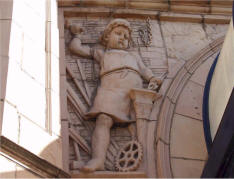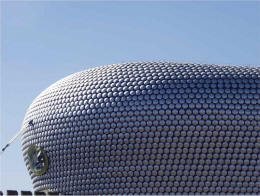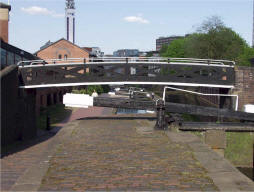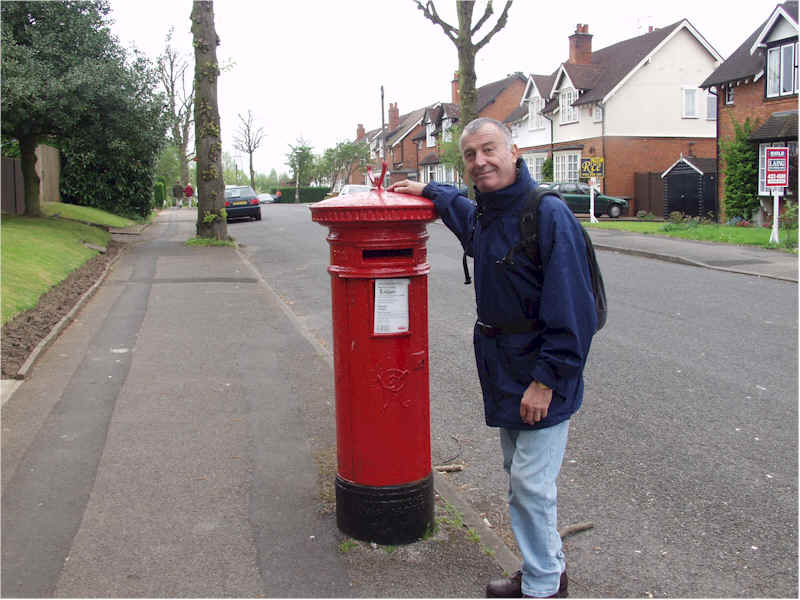|
BIRMINGHAM CITY SAFARI |
|
The Safari
introduced Birmingham and its commercial and industrial
heritage |
|
Birmingham has always been the second city in England after London partly due to its central position and its proximity to raw materials as well as its skilled workforce. In Victorian times, the city developed into an industrial powerhouse and flourished under the influence of politicians such as Joseph Chamberlain. The city is known for its jewellery manufacture, canals and chocolate making and these were some of the areas we focussed on during our visit to the city.
Detail on doorway of the Paragon Hotel |
|
On our first afternoon we explored the city’s commercial side, including a new city attraction, ‘the Beached Whale’ part of the newly refurbished Bull Ring site. Selfridge’s shop is an unusual shaped building, resembling a whale and covered in anodised aluminium discs. We saw some of the fine commercial architecture, which reflects both the civic pride of the city and its wealth in the 19th century, such as the terra cotta Victorian law courts, art deco shops and tiled shopping arcades as well as Birmingham’s Central Library, a classic 1960s inverted pyramid design. We also looked at some unusual industrial remains in St Philip’s Cathedral. The fine stained glass windows designed by Edward Burne Jones were made in the Merton Abbey Works of William Morris & Co. Burne Jones was born in Bennetts Hill, a few hundred yards away from the Cathedral. Close to all our walk routes ran Birmingham’s canals and close to the city centre we had a chance to see some of the restored canal-scape.
'The Beached Whale' |
|
On Saturday morning we made our way into the city through Digbeth and Deritend where we saw factories such as the former Bird’s Custard Factory and the former Typhoo Works, designed by the well-known cinema architect, Harry Weedon, as well as canal side remains including carriers’ warehousing. We also saw one of Birmingham’s best-known stations, Curzon Street station, the original terminus of the London-Birmingham railway. Close by is the Gun Barrel Proof House, another working reminder of Birmingham’s industrial past.
City centre canal scene |
|
Saturday afternoon was spent in the Jewellery Quarter to the north of the city centre. Here we saw the old Science Museum, housed in the former works of Thomas Elkington, pioneer of silver plating as well as the Birmingham Assay Office opposite. The area is undergoing a lot of modernisation and gentrification but a number of jewellers and businesses associated with their business still remain such as case and box makers. Here too ‘toy makers’ worked producing a large number of small fancy artefacts such as buttons and buckles especially in a wide variety of metals. In the centre of the area is St Paul’s Church where once both Matthew Boulton and James Watt worshipped. Their life in the city must wait for another Safari! |
|
Sunday we ventured south, to the suburb of Bourneville. It was here in 1879 that George Cadbury set up a new chocolate factory on a green field site. To attract workers he also started to build a model village in 1897 that was to provide housing for his workers as well as other artisans. This was one of the first such model villages and we will be able to compare and contrast the village here with that at Port Sunlight which we visited on our Safari to Liverpool. Other buildings of note in the village are the Women’s Baths of 1902, various schools as well as the village shops. George Cadbury also brought two buildings to the area, including Selly Oak Manor, which survive today and add to the area’s period charm.
Interesting pillar box with Phil Cox |




